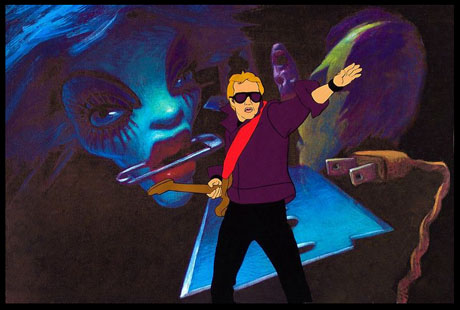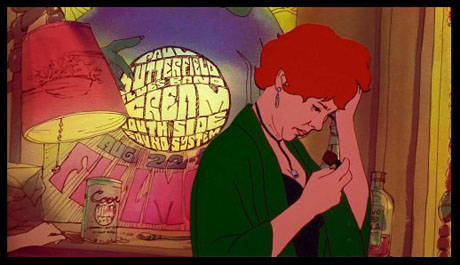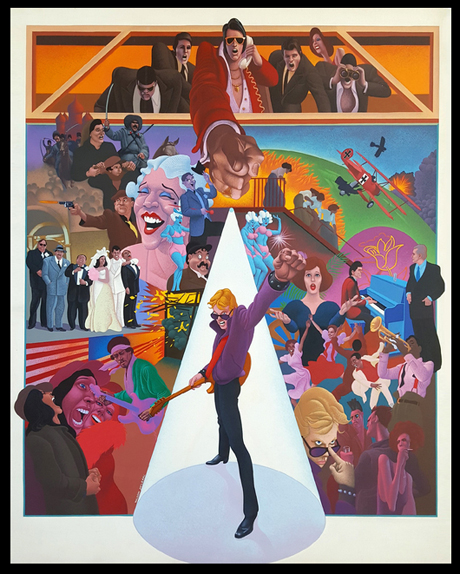Sure, today seemingly anything is possible in animation. Everything from bringing the internet to life as a “living world,” to soaring on the back of a dragon at dizzying heights can and has been realized.
However, even today’s filmmakers with the latest technology at their disposal, would be hard pressed to tackle a subject like, oh, the entire history of pop music in an animated film.
But this didn’t stop director Ralph Bakshi from doing just this with traditional, hand-drawn animation, in his ambitious feature film, American Pop.

The full-length feature, which was released on February 13th, 1981, celebrates its 40th anniversary this year, starts its story in the late 1890’s and tracks several generations, as it chronicles the inception and emergence of popular music.
American Pop opens like no other animated feature, using newsreel footage and silent movie-like title cards to depict a woman and her son, named Zalmie, escaping Russia, after their village is attacked and burned by Cossacks and the father, a rabbi, is killed.
Zalmie and his mother immigrate to New York City, where young Zalmie gets a job handing out flyers outside a burlesque show in the city. This proves to be Zalmie’s first introduction to music, as he grows up and spends time at the show.
Through the rest of the film, we then follow, Zalmie’s future generations of his family, including his son Bennie, who becomes a jazz pianist during World War II and his stepson Tony, who provides us a glimpse into the emergence of rock and roll (and sadly, subsequent drug addictions).
The story is then finally passed to Pete, in “contemporary times,” who turns his back on drugs, to focus on his music and the film concludes with him performing at a concert, as he successfully launches his career.

American Pop was a very personal film for Bakshi, as he was born in Palestine and his family eventually came to Brooklyn in New York City. He no doubt sought to create a film told that told the story of a similar American experience, using music as the backdrop for this.
Music, ranging from artists like Louis Prima to Bob Seger, plays across the soundtrack as almost one-hundred years of history pass by.
As he did in The Lord of the Rings, Bakshi uses the process of rotoscoping in the film. In this process, scenes in the film are filmed in live-action, after which animators trace over this footage. Developed by Dave Fleischer (most famous for the classic Popeye cartoon shorts), Rotoscoping helps capture realistic human movement and action.
Rotoscoping is seen as somewhat controversial, as many felt that the “tracing” didn’t necessarily equate with the draftsmanship and acting that one usually associates with an animator. Others argue that its purely a style or technique (similar to today’s motion capture) to bring the animated story to life.
Regardless of what “camp” as an animation enthusiast you may fall into, there’s no denying that Rotoscoping brings to life some very powerful and entertaining sequences in American Pop.

Poster Artwork by Wilson McLean
The opening sequence depicting the raid of the Cossacks is shocking and pulls the viewer in immediately. Bennie, while fighting in World War II, coming across a piano and being discovered by a Nazi soldier in a burned-out village, is heartbreaking; a rock group performing Jefferson Airplane’s “Somebody to Love” with news footage of the Vietnam War and rioting, along with psychedelic colors and an LSD trip, perfectly captures the ‘60’s; toward the end of the film, Pete’s drug dealing is set against Pat Benatar’s song “Hell is for Children,” with gritty realism.

Ralph Bakshi
From his debut with daring and landmark early features like the X-rated Fritz the Cat (1972) and Heavy Traffic (1973) to later sci-fi fantasies like Wizards (1977) and Fire & Ice (1983), Bakshi has always “swung for the fences” with his films and American Pop is no different.
In addition to tracing the birth of popular music, it’s subtle and not-so-subtle messages around the importance of generations connecting, creativity and pursuing one’s dreams through any challenge are those that many films today, particularly animated films, don’t explore.
In his 1981 review of American Pop in The New York Times, critic Vincent Canby summed up the film, and Ralph Bakshi perfectly, when he wrote that the director “…continues to push animation techniques to the outer limits more frequently explored by film makers who call themselves Avant Garde, but who seldom are.”


 Michael Lyons is a freelance writer, specializing in film, television, and pop culture. He is the author of the book, Drawn to Greatness: Disney’s Animation Renaissance, which chronicles the amazing growth at the Disney animation studio in the 1990s. In addition to Animation Scoop and Cartoon Research, he has contributed to Remind Magazine, Cinefantastique, Animation World Network and Disney Magazine. He also writes a blog, Screen Saver: A Retro Review of TV Shows and Movies of Yesteryear and his interviews with a number of animation legends have been featured in several volumes of the books, Walt’s People. You can visit Michael’s web site Words From Lyons at:
Michael Lyons is a freelance writer, specializing in film, television, and pop culture. He is the author of the book, Drawn to Greatness: Disney’s Animation Renaissance, which chronicles the amazing growth at the Disney animation studio in the 1990s. In addition to Animation Scoop and Cartoon Research, he has contributed to Remind Magazine, Cinefantastique, Animation World Network and Disney Magazine. He also writes a blog, Screen Saver: A Retro Review of TV Shows and Movies of Yesteryear and his interviews with a number of animation legends have been featured in several volumes of the books, Walt’s People. You can visit Michael’s web site Words From Lyons at: 






















I remember seeing “American Pop” with my friends when it came out in 1981. We all hated it. It suffers from the same problem as Baz Luhrmann’s “Moulin Rouge”, which was likewise built on a foundation of overly familiar pop music clichés. Songs that everybody knows come with a set of personal associations for each of us, some positive, some not. We remember the first time we heard them, where we were, what we were doing, who was with us. Shoehorning them into a narrative structure places the songs and our associations at cross purposes; the music and the story distract, and detract, from each other.
Compare Tom Hanks’s film “That Thing You Do”, a look at the American pop music scene of 1964, which contains no vintage songs at all, only originals. Yet they perfectly capture the style and atmosphere of that era. Bakshi would have been better off taking the million bucks he blew on licensing fees and hiring some good songwriters, conversant with a variety of historical styles, to come up with something made-to-order for his story. Not only would he have made a better movie, but he wouldn’t have had to wait so long for it to be released on home video.
I, too, saw it upon initial release. The first part of the film was pretty good, but, as you mentioned, things really fell apart at the rock and roll era. Their idea of “punk rock” was Bob Segar? The “bad ass” rock star rotoscoping looked like the actor knew nothing about holding a guitar. (Reminded me of the rock interludes from The Hilarious House of Frightenstein)
And, yeah, That Thing You Do nailed the ear perfectly and, despite some 3rd act issues, is a favorite movie of mine, too.
One of my local vintage theaters was showing American Pop a few years back as part of a month-long Bakshi movie-thon. It was a lot of fun seeing it on the big screen. I also got a chance to see Heavy Traffic there.
I want to live near that vintage theater.
My nickname for this flick is “American Flop”. To me it’s a waste of time and money. Such obvious and amateurish use of rotoscope! If Ralph wanted to make a live action movie, then why didn’t he? Ralph was a good cartoonist, yet wound up not trusting cartoon characters to tell his stories. His rotoscope period was a big disappointment to us cartoon fans.
I too have mixed feelings about heavy rotoscoping, but for “American Pop” it works better than in Bakshi’s other films. The story is a weird, unreal compression of history. It might conceivably have worked onstage or as a graphic novel, but not in live action or traditional animation unless the script was pounded into something more conventional. Here, the clear unreality of rotoscope fits the unreality of the material.
Among the touches I remember: The cartoony vaudeville horse (actual animation); the couch-potato boomer kids only moving their lips as their agitated brother roams the room; and the clown car full of musical wannabes. The last could easily have been a live action scene, but rotoscope made the silliness of it plausible within the story.
Liked it better than “Wizards” and “Lord of the Rings”, each of which would have been better served by either full animation or full live action.
Do you suppose Mr. Bakshi paid for the “Night They Raided Minsky’s” footage he rotoscoped for the burlesque segment?
Since Pete undoubtedly died of AIDS, I guess there’s not much chance of “American Pop II,” unless it turns out Tony has another congenitally miserable but musically gifted kid out there somewhere.
Why would the sequel have to follow the same family? If I did a sequel to this film. Id set starting in the 80s where this film ends. Maybe a Kid see’s pete on concert and that starts his Journey into music going from the 80s 90s 2000’s 2010s and ending in the 2020s With his decent finding his way into the music business. It doesn’t have to be a retelling. But we could go through the rest of the decades as well. Seeing another Rise and fall of each member of this family.
this is one of my favorite films, and bakshi’s best work by a massive margin. the rotoscope style here is incredibly effective at conveying the surreal, almost dream-like quality of the plot, and while some of the music choices are campy, they generally work for me (in particular, the version of Don’t Think Twice (It’s Alright) is the only version i listen to any more). the harmonica scene with This Train? priceless!
bakshi said in an interview once that he hated having used Bob Seger as the closer and that he wanted to use Free Bird but they couldn’t get the rights. i’m pretty sure, however, that this claim is entirely bogus, because Free Bird is used in the credits?
It wasn’t that they could not get the rights(because they did) It was the STUDIO EXCUTIVES that insested on them using Bob Seger in that scene. Free Bird was going to be in the scene but the Distributor insisted on the Bob Segar song on it.
I’ll never understand the frequent hate thrown at Bakshi’s films. While some are better than others, they were always ambitious and creative. Rotoscoping never bothered me. It still had to be drawn over and painted, which transforms it into something greater than just raw footage, much like Warhol’s screenprinting. I love his films and always will. Even the least of them have moments of brilliance. Give me Fritz the Cat, Heavy Traffic, Coonskin, Wizards, et al, any day over 90% of modern animated films.
Bakshi definitely pushed boundaries with most of his movies. Sometimes he made a good point, sometimes what he proposed was invalid, and many times both situations happened in the same film.I will admit to not being a fan of rotoscoping n matter who is doing it. One of the reasons usually stated even by the director is to save money.
I don’t see how rotoscoping would be cheaper than standard animation. With rotoscoping they have to have live actors act out the scenes, then they have to get animators to draw over the live action. Seems to me that skipping the live action filming & just using animators would be much cheaper. But I’m not a filmmaker.
As far as “American Pop” is concerned, it’s a phenomenal film! I don’t understand where all the shade is coming from in these comments towards Bakshi or AP. In my opinion, too often people place their own expectations or desires onto a movie instead of just letting a filmmaker tell them a story their own way. I think that’s why many people don’t enjoy what is clearly a good film.
Tony is not his Stepson. Tony is the Only Biological Child between Pulumbo’s Daughter and Bennie. Thats why he screamsWHY DO YOU CARE HE WASNT YOUR FATHER….to his siblings He was the child the two made in that mansion.